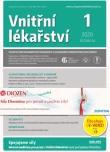What is the clinical use of total cholesterol results measurement?
Authors:
Vladimír Soška
Authors‘ workplace:
Oddělení klinické biochemie, FN u sv. Anny v Brně, II. interní klinika, LF MU Brno
Published in:
Vnitř Lék 2020; 66(1): 49-51
Category:
Differential Diagnosis Column or What You Can Be Asked at a Postgraduate Certification Exam
Overview
Assessment of total cholesterol concentration is one of the basic and relatively frequently determined blood analytes. However, significance of this parameter is limited to only a few areas: the main one is the estimation of the 10-year cumulative risk of the first fatal atherosclerotic event (myocardial infarction, stroke or other occlusive vascular disease including sudden cardiac death) according to the SCORE tables (Systematic Coronary Risk Estimation), where the knowledge of total cholesterol concentration cannot be dispensed with. This risk value can be also used to estimate the vascular age of the patient. Other main areas of application are: indicative evaluation of lipid metabolism at patient´s preventive examinations; along with other blood lipid parameters for differential diagnosis of dyslipidemias; in laboratories to calculate LDL-cholesterol and non HDL-cholesterol concentrations. However, at least triglyceride levels and serum appearance have to be taken into account to correctly interpret the total cholesterol result.
Keywords:
cholesterol – chylomicrons – triglycerides – LDL-cholesterol – VLDL-cholesterol
Sources
1. Betteridge DJ, Illingworth DR, Shepperd J. Lipoproteins in health and disease: Arnold, London; 1999. 1302 p.
2. Soška V. Poruchy metabolizmu lipidů - diagnostika a léčba. Praha: Grada Publishing; 2001. 180 p.
3. Friedewald WT, Levy RI, Fredrickson DS. Estimation of the concentration of low‑density lipoprotein cholesterol in plasma, without use of the preparative ultracentrifuge. Clin Chem 1972; 18 : 499–502.
4. Mach F, Baigent C, Catapano AL et al. 2019 ESC/EAS Guidelines for the management of dyslipidaemias: lipid modification to reduce cardiovascular risk. Eur Heart J 2019.
5. Miller M, Stone NJ, Ballantyne C et al. Triglycerides and cardiovascular disease: a scien ‑ tific statement from the American Heart Association. Circulation 2011; 123 : 2292–2333.
6. Miller WG, Myers GL, Sakurabayashi I et al. Seven direct methods for measuring HDL and LDL cholesterol compared with ultracentrifugation reference measurement procedures. Clin Chem 2010; 56 : 977–986.
7. Perk J, De Backer G, Gohlke H et al. European Guidelines on cardiovascular disease prevention in clinical practice (version 2012). The Fifth Joint Task Force of the European Society of Cardiology and Other Societies on Cardiovascular Disease Prevention in Clinical Practice (constituted by representatives of nine societies and by invited experts). Eur Heart J 2012; 33 : 1635–1701.
Labels
Diabetology Endocrinology Internal medicineArticle was published in
Internal Medicine

2020 Issue 1
Most read in this issue
- Sarcopenic obesity – current view
- Chronic stress, mental discomfort, and depression increase the rates of infectious, autoimmune as well as malignant diseases
- Odešel velký člověk a lékař prof. MUDr. Vítězslav Kolek, DrSc., FCCP
- Autoimmune hepatitis
